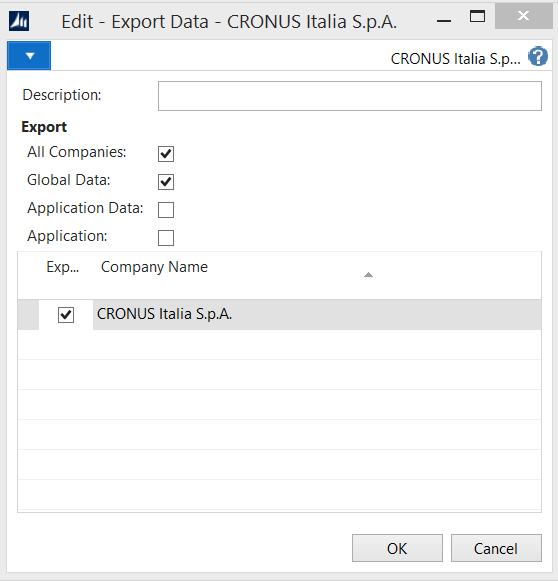Importing and Exporting Data in Microsoft Dynamics NAV 2013 R2 CU 8
In earlier versions of Microsoft Dynamics NAV, you could move or copy all or part of the data in a database by using the Microsoft Dynamics NAV backup functionality. In Microsoft Dynamics NAV 2013 R2, the support for the .fbk files was removed, but with Cumulative Update 8 for Microsoft Dynamics NAV 2013 R2, we introduce Windows PowerShell cmdlets so you can export data from a Microsoft Dynamics NAV database and import it into another Microsoft Dynamics NAV database. You can also export and import data in the Microsoft Dynamics NAV Windows client.
You can export and import a single company or all companies in a database, and you can export and import other types of data such as global data, application data, and application objects. As part of Cumulative Update 8, we include a whitepaper that provides examples of the types of data and how to export and import data using Windows PowerShell cmdlets as well as in the Microsoft Dynamics NAV Windows client.
When you export data from a Microsoft Dynamics NAV database, the data is stored in a file with the extension .navdata, which is a new file format that is proprietary to Microsoft Dynamics NAV data. You cannot edit the .navdata files in other tools.
The data that you export is not deleted from the original database. So that means that you can use the functionality to essentially take a copy of your customer’s live data, leave them to continue working, while you import the data into an offline database back at your office for further debugging or other investigation. You can also use the .navdata files to move data to a new database, such as moving a company to a new database when you want to deprecate a database, for example.
Exporting and Importing Data in the Microsoft Dynamics NAV Windows Client
To export or import data, in the Search box, enter Data File, and then choose the related link.
To export data, you specify the type of data that you want to export, and when you choose the OK button, you specify where you want to save the file.
To import data, you specify the .navdata file to import data from, but you can’t import an application if the .navdata file contains an application. This is because you can’t overwrite the application that is currently open in the Microsoft Dynamics NAV Windows client. So the window has one less type of data that you can choose to import:
If you want to import an application into a Microsoft Dynamics NAV database, you must use the Import-NAVData Windows PowerShell cmdlet.
Windows PowerShell Cmdlets
The following table describes the Windows PowerShell cmdlets that are new in Microsoft Dynamics NAV 2013 R2 Cumulative Update 8.
|
Name |
Description |
|
Export-NAVData |
Exports data from a Microsoft Dynamics NAV database. You can export company-specific data, and you can choose to include global data, application data, or application objects. |
|
Import-NAVData |
Imports data into a Microsoft Dynamics NAV database from a file. You can import all data in the file, or you can choose to include specific companies, global data, application data, or application objects. You can only import an application into an empty database. |
|
Get-NAVDataFile |
Gets information from a file that has been exported from a Microsoft Dynamics NAV database. The extracted information includes the types of data that the file contains and any company names. |
The cmdlets take different parameter sets depending on how you connect to the database that you want to export data from or import data into. You can access the database through the Microsoft Dynamics NAV Server instance, or you can access the database directly as described in the following table.
|
Access |
Description |
|
Through the Microsoft Dynamics NAV Server instance. |
Use parameter sets that include –ServerInstance when the database that you want to access is mounted against a Microsoft Dynamics NAV Server instance. The user account for the Microsoft Dynamics NAV Server instance must have access to write to the location that is specified by the –FileName parameter. |
|
Through a direct connection to the database. |
Use parameter sets that include –DatabaseServer and –DatabaseName when the Microsoft Dynamics NAV Server instance is stopped or not available. For example, if you want to import an updated application into a database, you stop the service so that users cannot access the database. You must have access to write to the location that is specified by the –FileName parameter. |
The following table describes the Windows PowerShell cmdlets that are modified in Microsoft Dynamics NAV 2013 R2 Cumulative Update 8.
|
Name |
Description |
|
Get-NAVCompany |
Gets a list of the Microsoft Dynamics NAV companies in the specified tenant database or exported Microsoft Dynamics NAV data file. The cmdlet has been updated to be able to get information from a Microsoft Dynamics NAV data file. |
However, the Help for the Export-NAVData and Import-NAVData Windows PowerShell cmdlets does not show the correct syntax when you run a command such as the following:.
PS C:\WINDOWS\system32> Get-Help Export-NAVData
Refer to the following syntax for the Export-NAVData cmdlet:
- Export-NAVData -DatabaseName <string> -FileName <string> [-DatabaseServer <string>] [-ApplicationDatabaseServer <string>] [-ApplicationDatabaseName <string>] [-Description <string>] [-IncludeApplication] [-IncludeApplicationData] [-IncludeGlobalData] [-CompanyName <string[]>] [-Force] [<CommonParameters>]
- Export-NAVData [-ServerInstance] <string> [[-Tenant]< TenantId>] -FileName<string> [-Description <string>] [-IncludeApplication] [-IncludeApplicationData] [-IncludeGlobalData] [-CompanyName <string[]>] [-Force] [<CommonParameters>]
- Export-NAVData [-ServerInstance] <string> [[-Tenant] <TenantId>] -FileName<string> -AllCompanies [-Description <string>] [-IncludeApplication] [-IncludeApplicationData] [-IncludeGlobalData] [-Force] [<CommonParameters>]
- Export-NAVData -DatabaseName <string> -FileName <string> -AllCompanies [-DatabaseServer <string>] [-ApplicationDatabaseServer <string>] [-ApplicationDatabaseName <string>] [-Description <string>] [-IncludeApplication] [-IncludeApplicationData] [-IncludeGlobalData] [-Force] [<CommonParameters>]
Refer to the following syntax for the Import-NAVData cmdlet:
- Import-NAVData [-FileName] <string> -DatabaseName <string> [-DatabaseServer <string>] [-ApplicationDatabaseServer <string>] [-ApplicationDatabaseName <string>] [-IncludeApplication] [-IncludeApplicationData] [-IncludeGlobalData] [-CompanyName <string[]>] [-Force] [-WhatIf] [-Confirm] [<CommonParameters>]
- Import-NAVData [-ServerInstance]< string> [[-Tenant] <TenantId>] [-FileName] <string> [-IncludeApplicationData] [-IncludeGlobalData] [-CompanyName <string[]>] [-Force] [-WhatIf] [-Confirm] [<CommonParameters>]
- Import-NAVData [-ServerInstance]< string> [[-Tenant] <TenantId>] [-FileName] <string> -AllCompanies [-IncludeApplicationData] [-IncludeGlobalData] [-Force] [-WhatIf] [-Confirm] [<CommonParameters>]
- Import-NAVData [-FileName] <string> -DatabaseName <string> -AllCompanies [-DatabaseServer <string>] [-ApplicationDatabaseServer <string>] [-ApplicationDatabaseName <string>] [-IncludeApplication] [-IncludeApplicationData] [-IncludeGlobalData] [-Force] [-WhatIf] [-Confirm] [<CommonParameters>]
You can find more information about this functionality, and the new or changed objects, in the following documents on the W1 version of the Microsoft Dynamics NAV 2013 R2 CU8 download media:
- MicrosoftDynamicsNAV2013R2CU8_ExportImportDataUsingNavDataFiles.pptx
- MicrosoftDynamicsNAV2013R2CU8_ImportExportData.pdf
In subsequent cumulative updates, the documents will be available in the country-specific downloads as well.







